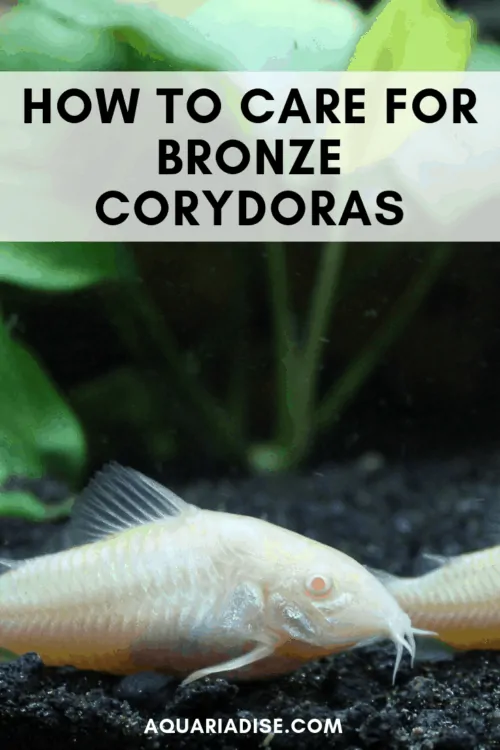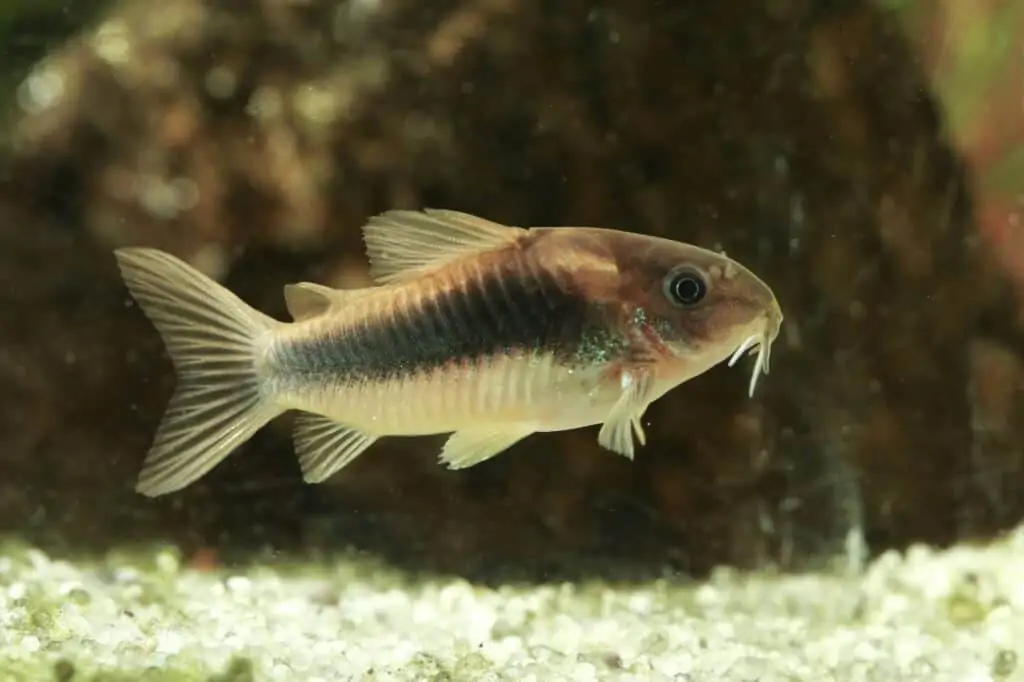The bronze Corydoras (Corydoras aeneus, also sometimes referred to as Green Corydoras) is one the most well-known and popular species of Corydoras that can be found in aquarium stores. They are available in many color variations, like black and albino, and are easy and fun fish to keep.
Keep reading for everything you need to know about this Corydoras variety!
This bronze Corydoras caresheet is a guest post by Jan from Aqua-fish.net!
| Minimum tank size | 20 gal (80 L, long) |
| Temperament | Peaceful |
| Diet | Omnivore |
| Temperature | 72-79 °F/22-26 °C |
| pH | 6-7 |

General information
Bronze cories are found naturally in South America, namely Argentina, Colombia and Venezuela, where they inhabit the water ways in large groups. Corydoras catfish belong to the family of Callichthyidae and are also known by the collective name of armoured catfish along with their close cousins.
The reason for this are the bony plates that cover their bodies and offer the fish some protection from predators. However, they are still quite delicate and have an adult size of only around 2.5 inches (6,5 cm), which means they do best with other peaceful species of fish that will not harass them!
Bronze Corydoras requirements
Their small size and relatively easy care makes bronze Corydoras suitable for beginner aquarists, but keep in mind that they are quite active and still need a cycled tank of at least around 20 gallons (80L).
- A shallow tank is preferred, as these fish inhabit shallow rivers in the wild. Like all Cory catfish, they are social fish and need the company of their own kind to settle properly in the aquarium. Keeping groups of at least six, preferably more, is recommended!
- The aquarium should be set up with a soft sand substrate, as Cories have delicate barbels. If these become damaged they are very prone to rot, especially combined with poor water quality.
- The bronze Cory can be a shy and retiring species; they require cover in the aquarium and as mentioned above, they also need to be kept in small groups of at least six specimens to prevent unnecessary stress. Add wood or rock formations to provide cover and use plenty of live plants to guarantee that they have somewhere to hide if they require it. Strangely enough, the more cover in the tank, the more that the fish tend to stay in the open knowing they can retreat if they need to!
- The lighting should be subdued; adding floating plants can help with this.
- The water temperature should be anywhere between 22-26 degrees C (72-79 degrees F) and pH can be kept around the neutral mark. If it drops below 7.0 slightly then all the better for the fish. Always use a reliable filter and help it out with regular water changes, at least 25% weekly. Never add salt to the tank while there are bronze Cory present, they are intolerant to this and it can burn them.
Bronze Corydoras diet
Feeding any species of Corydoras can be a difficult task because their tank mates tend to get the first pick of the food as it makes its way to the bottom of the tank. One way around this is to feed your bronze Cory just after the tank lights go out: at this time the other fish tend to become more sluggish and the Cory start to liven up. When feeding make sure that the bronze Cory get their fair share of the food. They are omnivorous and will accept most foods you offer.
A good idea is to go for a quality sinking pellet like Omega One for the staple diet. Algae wafers as well as the occasional meal of spirulina flake are also a good addition. For meaty foods, treats like blood worms, brine shrimp, daphnia or mysis twice a week will be appreciated. Be sure not to not over feed them on these, though, or they may lead to digestive problems.
Bronze Corydoras breeding
Breeding these fish is very simple, they are one of the easiest species of Corydoras to get to breed and don’t require too much coaxing from the keeper. Purchase a group of juveniles, six of these should guarantee that you get at least one breeding pair. When viewed from above the females will be slightly larger than the males and they will have a stockier body shape, especially when they start to swell with eggs.
The fish should mature in a few months and they can now be conditioned on regular meals of live or frozen foods to keep them strong during the spawning process. The females should look quite round, like the fish pictured above. Make sure that the water is slightly acidic and the quality is high! You can add some Java Moss or spawning mops to act as potential spawning sites, but the Cories may lay their eggs anywhere in the tank. An air driven sponge filter is sufficient for filtration.
The male will start to chase the female, and she will start to clean her chosen site. After this is completed, she’ll then start to chase the male. The two fish will assume the classic “T” position while mating and the eggs will de deposited. After spawning is complete, remove the parent fish and the eggs should hatch after 4-5 days.
The fry will initially consume their yolk sacs for 2-3 days before they are ready for feeding. Their first meals should consist of Infusoria or a fry food. A couple of weeks later the fry will be large enough to accept meals of newly hatched brine shrimp and a couple of weeks after that try them with micro worms. During the whole time perform regular water changes to keep the quality high or the fry will begin to suffer.
A big thank you to Jan from Aqua-fish.net for this interesting article on bronze Corydoras. If you have any more questions about these fish or want to share your own experiences with them, be sure to leave a comment below. Happy fishkeeping!


